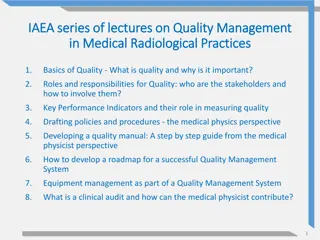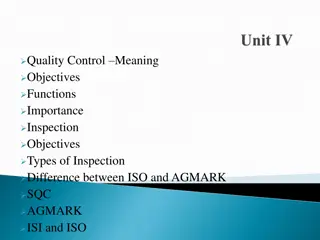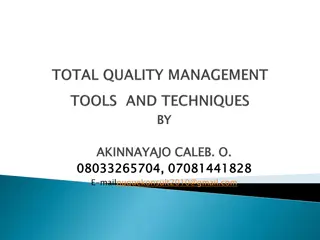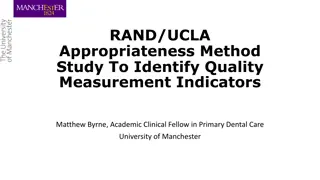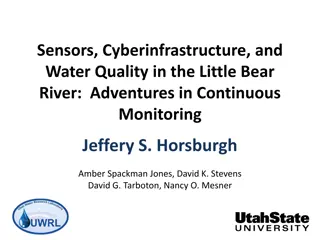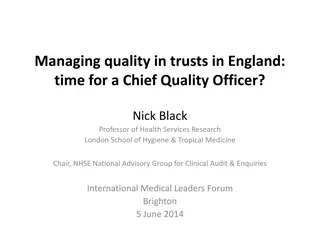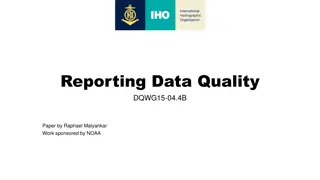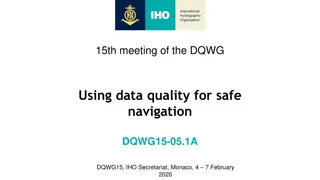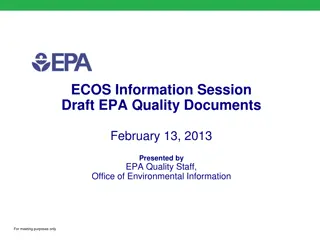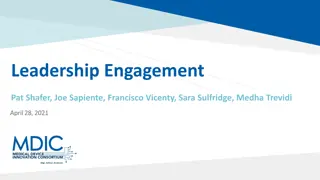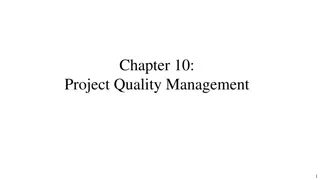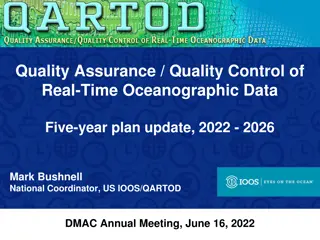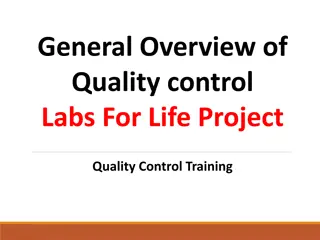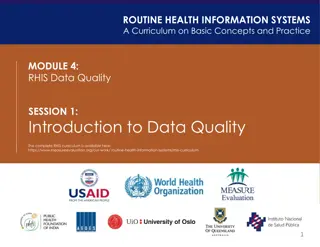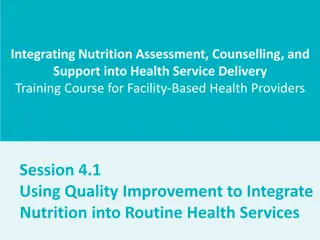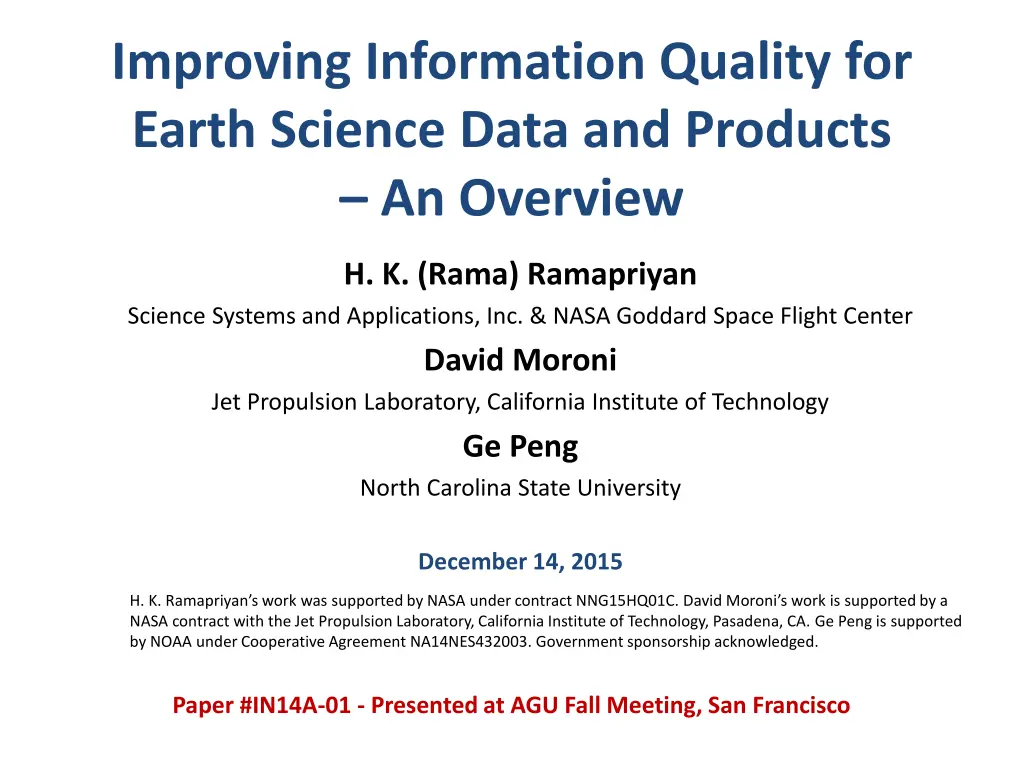
Enhancing Earth Science Data Quality: Overview and Objectives
Explore the initiative to improve information quality for Earth science data, including objectives, standards, and best practices for ensuring accuracy, completeness, and stewardship. Learn about various quality metrics, standards, and related initiatives in the field of Earth science data quality.
Download Presentation

Please find below an Image/Link to download the presentation.
The content on the website is provided AS IS for your information and personal use only. It may not be sold, licensed, or shared on other websites without obtaining consent from the author. If you encounter any issues during the download, it is possible that the publisher has removed the file from their server.
You are allowed to download the files provided on this website for personal or commercial use, subject to the condition that they are used lawfully. All files are the property of their respective owners.
The content on the website is provided AS IS for your information and personal use only. It may not be sold, licensed, or shared on other websites without obtaining consent from the author.
E N D
Presentation Transcript
Improving Information Quality for Earth Science Data and Products An Overview H. K. (Rama) Ramapriyan Science Systems and Applications, Inc. & NASA Goddard Space Flight Center David Moroni Jet Propulsion Laboratory, California Institute of Technology Ge Peng North Carolina State University December 14, 2015 H. K. Ramapriyan s work was supported by NASA under contract NNG15HQ01C. David Moroni s work is supported by a NASA contract with the Jet Propulsion Laboratory, California Institute of Technology, Pasadena, CA. Ge Peng is supported by NOAA under Cooperative Agreement NA14NES432003. Government sponsorship acknowledged. Paper #IN14A-01 - Presented at AGU Fall Meeting, San Francisco
ESIP Information Quality Cluster - Objectives Bring together people from various disciplines to assess aspects of quality of Earth science data Establish and publish baseline of standards and best practices for data quality for adoption by inter-agency and international data providers Become an authoritative and responsive resource of information and guidance to data providers on how best to implement certain data quality standards and best practices for their datasets Build framework for consistent capture, harmonization, and presentation of data quality for the purposes of climate change studies, Earth science and applications (Objectives evolve with participant inputs)
Information Quality Scientific quality Accuracy, precision, uncertainty, validity and suitability for use (fitness for purpose) in various applications Product quality how well the scientific quality is assessed and documented Completeness of metadata and documentation, provenance and context, etc. Stewardship quality how well data are being managed and preserved by an archive or repository how easy it is for users to find, get, understand, trust, and use data whether archive has people who understand the data available to help users. Information Quality is a combination of all of the above
Background QA4EO ISO 19157:2013 Standard Geographic information -- Data quality NOAA Climate Data Record (CDR) Maturity Matrix NOAA Data Stewardship Maturity Matrix NCAR Community Contribution Pages NASA Making Earth System Data Records (ESDRs) for use in Research Environments (MEaSUREs) Product Quality Checklists NASA Earth Science Data System Working Groups (ESDSWG) Data Quality Working Group Much related work has occurred in recent years
QA4EO Established and endorsed by the Committee on Earth Observation Satellites (CEOS) in response to a Group on Earth Observations (GEO) Task DA-06-02 (now Task DA-09-01a) Four International Workshops - 2007, 2008, 2009, and 2011 Key Principles (from http://qa4eo.org/docs/QA4EO_guide.pdf) In order to achieve the vision of GEOSS, Quality Indicators (QIs) should be ascribed to data and products, at each stage of the data processing chain - from collection and processing to delivery A QI should provide sufficient information to allow all users to readily evaluate a product s suitability for their particular application, i.e. its fitness for purpose . To ensure that this process is internationally harmonized and consistent, the QI needs to be based on a documented and quantifiable assessment of evidence demonstrating the level of traceability to internationally agreed (where possible SI) reference standards. Framework and 10 Key Guidelines established (e.g., establishing Quality Indicator , establishing measurement equivalence, expressing uncertainty) A few cases studies are available that illustrate QA4EO-compliant methodologies [e.g., NOAA Maturity Matrix for CDRs, WELD: Web - Enabled Landsat Data (NASA-funded MEaSUREs Project), ESA Sentinel-2 Radiometric Uncertainty Tool]
ISO 19157:2013 - Geographic information -- Data quality* Establishes principles for describing the quality of geographic data Defines components for describing data quality Specifies components and content structure of a register for data quality measures Describes general procedures for evaluating the quality of geographic data Establishes principles for reporting data quality Defines a set of data quality measures for use in evaluating and reporting data quality Applicable to data producers providing quality information to describe and assess how well a data set conforms to its product specification Applicable to data users attempting to determine whether or not specific geographic data are of sufficient quality for their particular application Examples of DQ Elements: Completeness, Thematic Accuracy, Logical Consistency, Temporal Quality, Positional Accuracy * From: http://www.iso.org/iso/home/store/catalogue_tc/catalogue_detail.htm?csnumber=32575
CDR Maturity Matrix NOAA NCEI Climate Data Record (CDR) Maturity Matrix assesses readiness of a product as a NOAA satellite CDR Bates, J. J. and Privette, J. L., A Maturity Model for Assessing the Completeness of Climate Data Records , Eos, Vol. 93, No. 44, 30 October 2012 Assesses maturity in 6 categories (software readiness, metadata, documentation, product validation, public access, utility) at 6 levels Provides consistent guidance to data producers for improved data quality and long-term preservation EUMETSAT s CORE-CLIMAX Matrix based on CDR Maturity Matrix; contains guidance on uncertainty measures http://www1.ncdc.noaa.gov/pub/data/sds/cdr/Guidelines/Mat urity_Matrix_Template.xlsx
Data Stewardship Maturity Matrix NOAA NCEI/CICS-NC Scientific Data Stewardship Maturity Matrix (SMM) provides a unified framework for assessing the maturity of measurable stewardship practices applied to individual digital Earth Science datasets that are publicly available Assesses maturity in 9 categories (e.g., preservability, accessibility, data quality assessment, data integrity) at 5 levels Provides understandable data quality information to users including scientists and actionable information to management Peng, G. et al, 2015. A unified framework for measuring stewardship practices applied to digital environmental datasets , Data Science Journal, 13. doi:10.2481/dsj.14-049 More details in paper #IN14A-05
NCAR Climate Data Guide* Community contributed datasets, reviews Focuses on limited selection of data sets that are most useful for large-scale climate research and model evaluation Contributed reviews answer 10 key questions; Examples of topics addressed strengths, limitations, and typical applications of datasets Comparable datasets Methods of uncertainty characterization utility for climate research and model evaluation. *From Schneider, D. P., et al (2013), Climate Data Guide Spurs Discovery and Understanding, Eos Trans. AGU, 94(13), 121. [article] - See more at: https://climatedataguide.ucar.edu/about/contribute-climate-data- guide#sthash.zaOUYP3j.dpuf
NASA MEaSUREs - Product Quality Checklists Making Earth System Data Records for Use in Research Environments (MEaSUREs) NASA-funded, typically 5-year projects generating long-term consistent time series Product Quality Checklists (PQC) indicate completeness of Quality Assessment, metadata, documentation, etc. PQC templates - developed in 2011 and adopted in 2012 Questions asked address science quality, documentation quality, usage and user satisfaction
NASA Earth Science Data System Working Groups (ESDSWG) Data Quality Working Group (DQWG) Mission: Assess existing data quality standards and practices in the inter-agency and international arena to determine a working solution relevant to Earth Science Data and Information System Project (ESDIS), Distributed Active Archive Centers (DAACs), and NASA-funded Data Producers. Initiated in March 2014 2014-2015: 16 use cases analyzed, issues identified from users points of view and ~100 recommendations made for improvement Consolidated into 12 high-priority recommendations 2015-2016: Extracted 4 Low Hanging Fruit (LHF) recommendations from previous 12 Implementation strategies for comprehensive integration across NASA ESDIS have been scoped out for LHF rec s. Details will be covered in paper #IN14A-08
ESIP Information Quality Cluster Activities Coordinate use case studies with broad and diverse applications, collaborating with the ESIP Data Stewardship Committee and various national and international programs Identify additional needs for consistently capturing, describing, and conveying quality information Establish and provide community-wide guidance on roles and responsibilities of key players and stakeholders including users and management Prototype innovative ways of conveying quality information to users Evaluate NASA ESDSWG DQWG recommendations and propose possible implementations. Establish a baseline of standards and best practices for data quality, collaborating with the ESIP Documentation Cluster and Earth Science agencies. Engage data providers, data managers, and data user communities as resources to improve our standards and best practices.
Thank you for your attention! Hampapuram.ramapriyan@ssaihq.com David.F.Moroni@jpl.nasa.gov Ge.Peng@noaa.gov
NOAA CDR Maturity Matrix Maturity Software Readiness Metadata Documentation Product Validation Public Access Utility Draft Climate Algorithm Theoretical Basis Document (C-ATBD); paper on algorithm submitted 1 Conceptual development Little or none Little or None Restricted to a select few Little or none Significant code changes expected C-ATBD Version 1+ ; paper on algorithm reviewed Limited data availability to develop familiarity 2 Research grade Minimal Limited or ongoing Research grade; Meets int'l standards: ISO or FGDC for collection; netCDF for file Data and source code archived and available; caveats required for use. 3 Moderate code changes expected Public C-ATBD; Peer-reviewed publication on algorithm Uncertainty estimated for select locations/times Assessments have demonstrated positive value. Exists at file and collection level. Stable. Allows provenance tracking and reproducibility of dataset. Meets international standards for dataset Public C-ATBD; Draft Operational Algorithm Description (OAD); Peer- reviewed publication on algorithm; paper on product submitted Uncertainty estimated over widely distributed times/location by multiple investigators; Differences understood. Data and source code archived and publicly available; uncertainty estimates provided; Known issues public May be used in applications; assessments demonstrating positive value. 4 Some code changes expected Complete at file and collection level. Stable. Allows provenance tracking and reproducibility of dataset. Meets international standards for dataset Record is archived and publicly available with associated uncertainty estimate; Known issues public. Periodically updated Public C-ATBD, Review version of OAD, Peer-reviewed publications on algorithm and product Consistent uncertainties estimated over most environmental conditions by multiple investigators May be used in applications by other investigators; assessments demonstrating positive value Minimal code changes expected; Stable, portable and reproducible 5 Updated and complete at file and collection level. Stable. Allows provenance tracking and reproducibility of dataset. Meets current international standards for dataset Observation strategy designed to reveal systematic errors through independent cross- checks, open inspection, and continuous interrogation; quantified errors No code changes expected; Stable and reproducible; portable and operationally efficient Public C-ATBD and OAD; Multiple peer-reviewed publications on algortihm and product Used in published applications; may be used by industry; assessments demonstrating positive value Record is publicly available from Long-Term archive; Regularly updated 6 14

